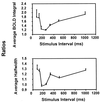An approach to probe some neural systems interaction by functional MRI at neural time scale down to milliseconds
- PMID: 11005873
- PMCID: PMC27142
- DOI: 10.1073/pnas.97.20.11026
An approach to probe some neural systems interaction by functional MRI at neural time scale down to milliseconds
Abstract
In this paper, we demonstrate an approach by which some evoked neuronal events can be probed by functional MRI (fMRI) signal with temporal resolution at the time scale of tens of milliseconds. The approach is based on the close relationship between neuronal electrical events and fMRI signal that is experimentally demonstrated in concurrent fMRI and electroencephalographic (EEG) studies conducted in a rat model with forepaw electrical stimulation. We observed a refractory period of neuronal origin in a two-stimuli paradigm: the first stimulation pulse suppressed the evoked activity in both EEG and fMRI signal responding to the subsequent stimulus for a period of several hundred milliseconds. When there was an apparent site-site interaction detected in the evoked EEG signal induced by two stimuli that were primarily targeted to activate two different sites in the brain, fMRI also displayed signal amplitude modulation because of the interactive event. With visual stimulation using two short pulses in the human brain, a similar refractory phenomenon was observed in activated fMRI signals in the primary visual cortex. In addition, for interstimulus intervals shorter than the known latency time of the evoked potential induced by the first stimulus ( approximately 100 ms) in the primary visual cortex of the human brain, the suppression was not present. Thus, by controlling the temporal relation of input tasks, it is possible to study temporal evolution of certain neural events at the time scale of their evoked electrical activity by noninvasive fMRI methodology.
Figures







References
Publication types
MeSH terms
Grants and funding
LinkOut - more resources
Full Text Sources
Other Literature Sources
Medical

